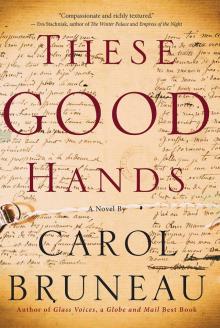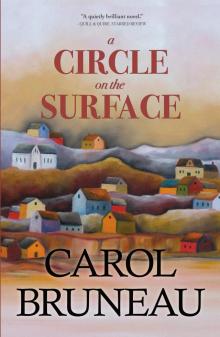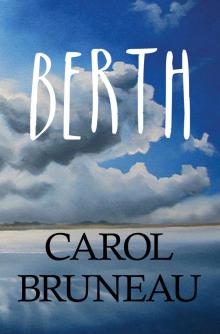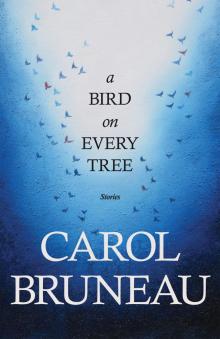- Home
- Carol Bruneau
A Circle on the Surface Page 30
A Circle on the Surface Read online
Page 30
Over the years he has grown more and more certain that its writer must be, is, her father. But whoever her father is or was no longer matters—if, in fact, it ever truly did. Pen looks like herself.
“I love you, and not just because I raised you,” he imagines Ma saying.
So he begins, stalling for time, a little:
“Let me tell you what I can about the person who gave birth to you. Let me tell you what I know about her.”
Then he hesitates. Changing tack, he tells her how much, in fact, she was wanted. Wanted with everything he and that person were made of. How much she is loved. How much she has taught him about love and something of the need not to cling to your ideas of what love means but to be willing at times to let these ideas go.
“Guess what? You’re stuck with me. And not just because I’ve put up with, um, raised you, Pen.”
One of her favourite jokes.
She wrinkles her nose, scowls. Is there anything known to nature that’ll match a teenager’s disgust? “That’s it? That’s all?” No longer a child, she is not old enough, or wise enough, or woman enough—yet—to be made weary by the things that wear you down, that wear you out.
“I didn’t really know your mum, not very well. Not the way I wish I had. Not the way I should have,” he apologizes. Reaching inside his jacket, he takes out the letter. He slides it gently across the tabletop and into her hands. Smooth, nimble hands that are warm, and still small enough to be a child’s. The way they have always fit into his.
His own beautiful child’s.
“Perhaps,” he tells her, “perhaps this person knew her a little bit better.”
Author’s Note
Rumours abounded about U-boat crews coming ashore in Atlantic Canada during the Second World War, rumours largely based on hearsay and dismissed as fable. Enman and Una’s tale is exactly this, a fable. Barrein and O’Leery are imaginary places, though they share a few geographical features with communities in Halifax’s Mainland South. Mad Rock, though, is as “real” as real can be, a shoal charted at 44° 25’ 52" N, 063° 33’ 37" W near Sambro Island, and part of the treacherous Sambro Ledges, the site of countless shipwrecks. Neverfail is a shoal in Halifax Harbour, first documented in 1826, named in 1853 by Royal Navy surveyer Captain Bayfield, and ever since 1893, marked by a succession of can, light, and bell buoys. One of dozens of navigational aids in the world’s second-largest natural harbour, as it operates today the Neverfail Shoal Light and Bell Buoy is marked H8 on the Canadian Coast Guard’s List of Lights, Buoys and Fog Signals, its List of Lights number 518. Its position is 44°33'15.5"N, a location off Bear Cove, between Chebucto Head and Tribune Head near Herring Cove. In 1943, the year this story takes place, a black can buoy with “Neverfail” painted on it was laid to mark “a 4½ fathom patch” while its corresponding light and bell buoy was moved “about one cable to the south,” according to the late Rear Admiral Hugh F. Pullen. This is the marker Enman and his friends kept an eye out for. Just so you know.
Acknowledgements
Thanks beyond measure to the Wonder Women at Nimbus/Vagrant, the amazing Whitney Moran, Terrilee Bulger, Elaine McCluskey, Heather Bryan, Emily MacKinnon, and Karen McMullin, as well as to Matthew McNeill. Thanks to my brilliant editor, Bethany Gibson, who asked the many tough questions that helped to anchor fable with realism and make the novel what it needed to be. Thanks to my writers’ group, Lorri Neilsen Glenn, Binnie Brennan, and Ramona Lumpkin, for their encouragement and grit. Thanks to the National Museum of War in Ottawa, Maritime Command, the Maritime Museum of the Atlantic, Veronica Stevenson at the Canadian Coast Guard Marine Communications and Traffic Services (MCTS), and the Mainland South Heritage Society, all in Halifax. Thanks to Cindy Handren, Shawn Brown, and Dawn Rae Downton for all our laughter. Thanks to Dan Conlin for his tour of Sambro Island and sharing the tale of the Devil’s Staircase. Thanks to the late William Naftel and to Stephen Kimber for their books on Second World War–era Halifax, and to the late Rear Admiral Hugh F. Pullen, RCN, for The Sea Road to Halifax: Being an Account of the Lights and Buoys of Halifax Harbour (1980), which contains L. B. Jenson’s 1976 drawing of the Neverfail Shoal light and bell buoy. Thanks to William Hall’s 1912 Navigation in The People’s Books series, for elucidating, sort of, why someone might call a ship a she. The passages on eugenics and child-bearing which appear in the novel are borrowed from Millard Spencer Everett’s The Hygiene of Marriage, 1942 edition, pages 132 to 135. My deepest thanks go, as always, to my sons, Andrew, Angus, and Seamus Erskine, who drew me to Alex Colville’s 1995 serigraph, Navigation, an image which helped clarify my vision of Una. Most of all my thanks go to Bruce Erskine, for riding my writerly waves and being my patient, life-saving buoy during the intensive rewriting and revising of this book. Without your love and support, I would be a dustball under my desk, seriously.
Other Books by Carol Bruneau
After the Angel Mill
Depth Rapture
Purple for Sky
Berth
Glass Voices
These Good Hands
A Bird on Every Tree
Available at fine bookstores everywhere, and online at nimbus.ca

 These Good Hands
These Good Hands A Circle on the Surface
A Circle on the Surface Glass Voices
Glass Voices Berth
Berth Brighten the Corner Where You Are
Brighten the Corner Where You Are A bird on every tree
A bird on every tree